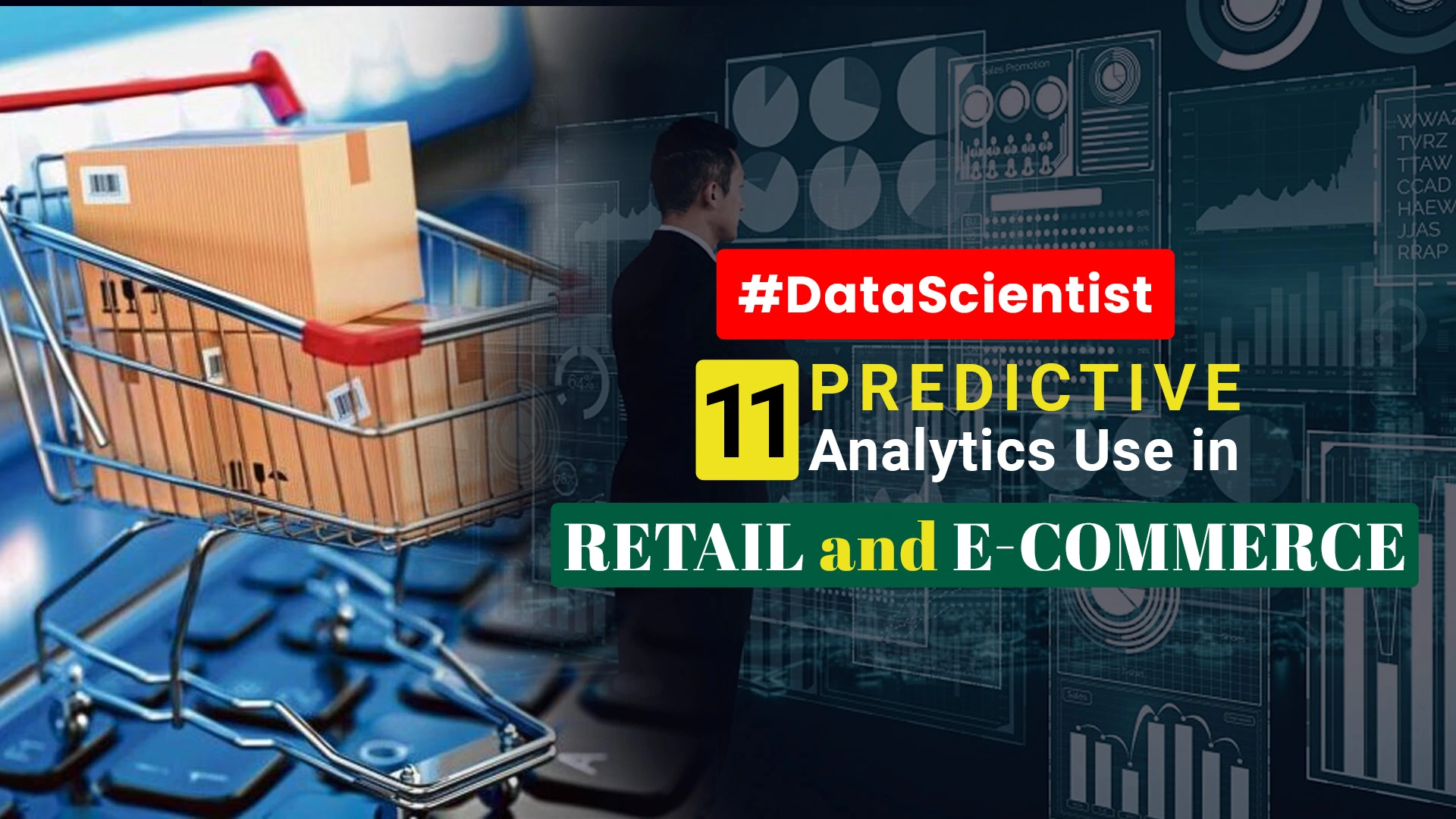How do data scientists optimize e-commerce and retail businesses?
Retail and e-commerce companies can increase customer engagement, boost conversion rates, and encourage customer loyalty by implementing a personalized marketing strategy that is driven by data scientists. Customers receive personalized interactions and pertinent offers, which enhances their shopping satisfaction and boosts revenue for the company.
To increase sales and improve the overall customer experience, data scientists are essential in optimizing product recommendations, demand forecasting, inventory management, pricing strategies, and customer segmentation.
Advertisement
Implementing predictive analytics is one extremely successful tactic data scientists use in the e-commerce and retail sectors. To make predictions and forecasts, this strategy makes use of historical data, statistical modeling, and machine learning algorithms. Along with some frequently used software tools, here is how it functions:
Strategic Use of Predictive Analytics:
1. Data Collection: Data scientists collect relevant data from a variety of sources, including customer transactions, website interactions, marketing campaigns, and extraneous elements like seasonality and economic indicators.
Advertisement
2. Data Cleaning and Preprocessing: To ensure the data’s quality and dependability, they clean and preprocess it, eliminating any discrepancies, missing values, or outliers.
3. Data scientists use feature engineering to extract significant features from the data and turn the raw data into variables that can be incorporated into predictive models. For instance, they might develop features like average order value, customer purchase frequency, or product popularity ratings.
Advertisement
4. Model building: Data scientists create predictive models using software tools and programming languages like Python or R. When building models from past data, they may use strategies like regression analysis, decision trees, random forests, or neural networks to spot patterns and relationships.
5. Model Evaluation and Selection: Using evaluation metrics like accuracy, precision, recall, or mean squared error, data scientists evaluate the performance of various models. They decide which model will work the best before deploying it.
6. Deployment and Monitoring: After the model is put into use, data scientists keep an eye on it to make sure it is still accurate and current. To maintain the model’s efficiency, they might retrain it periodically using fresh data.
7. Customer segmentation: Data scientists divide customers into distinct groups based on shared traits and behaviors by using advanced analytics techniques. Different customer profiles, such as devoted customers, high spenders, first-time buyers, or customers interested in particular product categories, can be identified with the help of this segmentation.
8. Personalized Recommendations: Data scientists develop algorithms that generate personalized product recommendations based on individual customer preferences and behaviors. These recommendations are displayed on the website, through email campaigns, or on mobile apps, providing customers with tailored suggestions that align with their interests and increase the likelihood of purchase.
9. Targeted Marketing Campaigns: Data scientists use customer segmentation to create targeted marketing campaigns. By understanding the preferences, needs, and purchase patterns of different customer groups, they can tailor marketing messages and offers to resonate with each segment. This ensures that customers receive relevant promotions, discounts, or product suggestions that are more likely to drive conversion.
10. Behavioral Retargeting: Data scientists leverage behavioral retargeting techniques to re-engage customers who have shown interest but did not complete a purchase. By analyzing their browsing behavior and cart abandonment data, personalized ads or emails can be delivered to remind customers of the products they are considering and encourage them to complete their purchases.
11. Customer Lifetime Value Analysis: Data scientists analyze customer data to predict customer lifetime value (CLV). This helps identify high-value customers who are likely to make repeat purchases and have a long-term relationship with the brand. Retailers can then allocate resources and implement retention strategies to maximize the value of these customers.
By implementing a personalized marketing strategy driven by data scientists, e-commerce and retail businesses can enhance customer engagement, improve conversion rates, and drive customer loyalty. Customers receive tailored experiences and relevant offers, resulting in a more satisfying shopping experience and increased sales for the business.
Software Tools for Analysis:
- Python is a popular programming language with libraries like Pandas, NumPy, and sci-kit-learn that offer strong tools for modeling, data analysis, and manipulation.
- R is a statistical programming language with a large selection of libraries and packages for data analysis and forecasting.
- Large databases can be queried and altered using SQL (Structured Query Language) to extract pertinent data for analysis.
- Tableau is a well-known tool for data visualization that enables data scientists to design engaging dashboards that effectively convey insights and trends.
- Spark and Apache Hadoop are distributed computing frameworks that make it possible for data scientists to quickly process and analyze large datasets.
These software tools enable data scientists to learn new things, predict the future, and help people make well-informed decisions in e-commerce and retail. Businesses can increase sales and customer satisfaction by using predictive analytics to optimize inventory management, personalize marketing campaigns, enhance pricing strategies, and improve the overall customer experience.
To demonstrate how data scientists work in e-commerce and retail, consider the following numerical examples:
1. Product Recommendations:
- Amazon, a major online retailer, reported a 29% increase in sales after implementing personalized product recommendations.
- Netflix’s data-driven recommendation algorithm is thought to save the company $1 billion annually by lowering retention rates.
2. Demand prediction:
- a. Through accurate demand forecasting, Walmart was able to reduce its out-of-stock inventory by 16%, which increased customer satisfaction and sales.
- b. Data-driven demand forecasting, which enables the fashion retailer Zara to react quickly to trends and eliminate excess inventory, is credited with its success.
3. Inventory Management:
- a. To optimize inventory levels and prevent stockouts, the clothing retailer Gap increased inventory turnover by 13%.
- b. Target was able to reduce excess inventory by $2 billion because of its data-driven approach to inventory management.
4. Pricing Techniques:
- a. Airlines like Delta and American Airlines adjust ticket prices in real time based on data analysis to maximize revenue per flight.
- b. Uber uses surge pricing to balance supply and demand during times of high demand, ensuring effective driver distribution and maximizing profits.
5. Customer segmentation
- a. By dividing their customer base into distinct groups and targeting particular groups with their marketing campaigns, online retailer ASOS increased conversion rates by 300%.
- b. To personalize offers and promotions and increase customer loyalty and sales, Starbucks uses customer segmentation.
Next Article to Read
- YouTube Creators Video: Altered Content Update 2024
- Nowruz Treasures: 10 Remarkable Gift Ideas and 6 Sentimental Wishes for the New Year 2024
- 12 Easy Steps to Make Money Online (YouTube Money Calculator)
- Facebook Messenger ‘Meta AI’ Upgrade : Tech News 2024
- Apple News: 5G Modem Challenges / 6G Modem Exploration 2024
- Optimize Your Cover Letter Using a Word Counter: Land Your Dream Job Efficiently!
- Best Word Count Tool to Unlock Your Creative Earning Potential – 3 Easy Steps
- Increase Website Traffic, SEO, and 50 Free High 60+ DA Backlinks
- 100 successful Pinterest Images – Vertical Banner Design
- Make money online – Increase Website Traffic and Boost Your Online Presence using the Top 10 AI Tools
People also read this
- Top 10 Online Marketing Strategies to Skyrocket Your ROI
- 10 Whatsapp promotional messages to help you promote the sale of your products
- Get Monetized Potential of Facebook Instream Ads: Eligibility, Content Policies, and Earning Possibilities
- How to use Twitter job search to your advantage and receive job alerts instantly
- 20 Best Affiliate Marketing Programs for April and How to Make Money
- Learn 5 importance of branding services for professional businesses, e-commerce products, and industrial services
- Data Analyst Job | Download 6 Cover letter formats and ATS-optimized resumes for various Industries
- Learn the advanced SQL techniques for data analysis and perform with 100% confidence – Experienced
- Learn these SQL codes before the interview and perform with 100% confidence – Freshers
- Generate “Short Stories” and Make Money from home


























